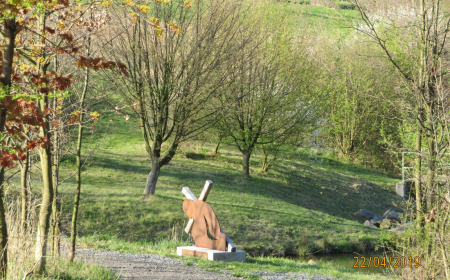The Way of the Cross
The Way of the Cross is a symbolic journey mapping the events connected to the crucifixion of Jesus Christ. It includes the events surrounding his conviction, carrying the cross and the crucifixion itself on Golgotha. The Way of the Cross typically consists of 14 Stations, which correspond to the individual Passions. Recently, one last Station has been added to the Way of the Cross – the Resurrection. The Way of the Cross is a manifestation of piety, deriving from medieval tradition, when pilgrims visited sacred places in the Holy Land, including the Holy Sepulchre and Golgotha. In order to succesfully carry out the pligramage from Europe to the Middle East at that time, commitment, good health, financial security, and independence were needed. With serfdom at its peak, most inhabitants had no freedo of movement, as they were bound to work on the land of their nobility. In order to bring the sites of the Holy Land closer to the common people, models of the Holy Sepulchre, Golgotha and other holy places were being built. Gradually, the 14 Stations of the Way of the Cross were formed. The Way is meant to provide people with courage and inner strength to overcome their weaknesses.
The Ways of the Cross have become an enormous source of inspiration for painters, woodcarvers, sculptors and other artists. Many of their works are true masterpieces. In churches, the Way of the Cross can mainly be found in the form of paintings or bas-reliefs, while in the landscape, it usually takes the form of a series of niche chapels or wayside shrines.
The Way of the Cross is usually performed during Lent and on Good Friday. The people go through the individual Stations of the Way of the Cross, singing, meditating or praying, or simply just walking through the nature or city streets.
The individual Stations
I. Jesus is condemned to death
II. Jesus Christ bears the Cross
III. Jesus Christ falls under the Cross for the first time
IV. Jesus Christ meets His Mother
V. Simon of Cyrene helps Jesus to bear the Cross
VI. Veronica wipes the face of Jesus
VII. Jesus falls under the Cross for the second time
VIII. Jesus admonishes the crying women
IX. Jesus falls under the Cross for the third time
X. Jesus’s clothes are taken awayl
XI. Jesus is nailed to the Cross
XII. Jesus Christ dies on the Cross
XIII. The body of Jesus is taken down from the Cross
XIV. The body of Jesus Christ laid in the tomb
XV. Jesus is resurrected
Back






